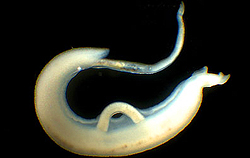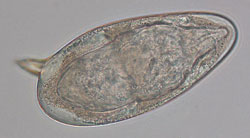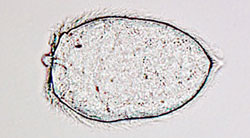Lifecycle
Learn more about the life cycle of Schistosoma mansoni the parasite that causes schistosomiasis.

A Schistosoma mansoni male/female reproductive pair found in intestinal blood vessels. © A Emery
Adults
Mature adult Schistosoma mansoni are about 1 cm long.
The male and female form a reproductive pair, with the female held by the male within a groove.
Females release eggs, into the blood vessels.
A pair may live for years within the host, the female producing thousands of eggs during this time.
Eggs

Schistosoma mansoni egg. The egg has a characteristic lateral spine. The miracidium stage can be seen within the egg. © A Emery
- passed out through the wall of the host's intestine.
- circulating in the blood cause much of the pathology associated with schistosomiasis, as they become trapped in the liver and other internal organs.
The eggs in the intestine pass out of the body with faeces and if they come into contact with fresh water, hatch into a free-living life-cycle stage called the miracidium.
Miracidium stage

The miracidium is a short-lived free-swimming stage of Schistosoma mansoni that infects snails. © A Emery
- swim about in the water, propelled by the many cilia that cover them.
- never feed
- live for about a day
Miracidia must locate and infect another host freshwater snails (genus Biomphalaria) to continue the life-cycle. Within the snail, a miracidium transforms into a sporocyst – a factory for producing the next life-cycle stage, the cercaria.
Cercaria stage

The cercaria is the life-cycle stage of Schistosoma mansoni infecting humans. © A Emery
The spororcyst produces cercariae through asexual reproduction, so that one miracidium can produce many thousands of genetically identical cercariae. Somewhere around 3-4 weeks after being infected, the snail begins to shed cercariae into the water. Like miracidia, cercariae
- do not feed
- live for about a day
- propel themselves with an actively
beating tail, swimming tail-first through the water.
The cercaria is the stage that infects humans. Cercariae infect their human host by penetrating through the skin. In about a month, the cercariae have developed into mature schistosomes that have formed pairs, migrated to the blood vessels around the intestine and have begun to produce eggs.
Reproductive pair
The male and female form a reproductive pair the female held by the male within a groove
The name Schistosoma means 'split body'.
Miracidium
Miracidium are a short-lived free-swimming stage of Schistosoma mansoni that infects snails
Cercaria
Cercaria are the life-cycle stage of Schistosoma mansoni released from freshwater snails that infects humans